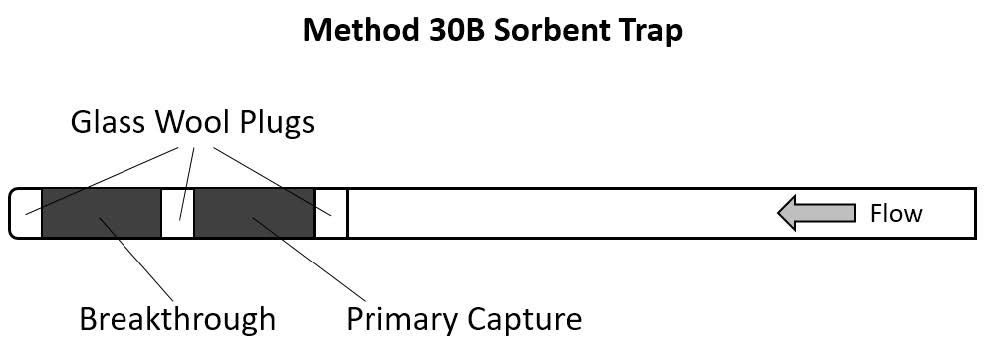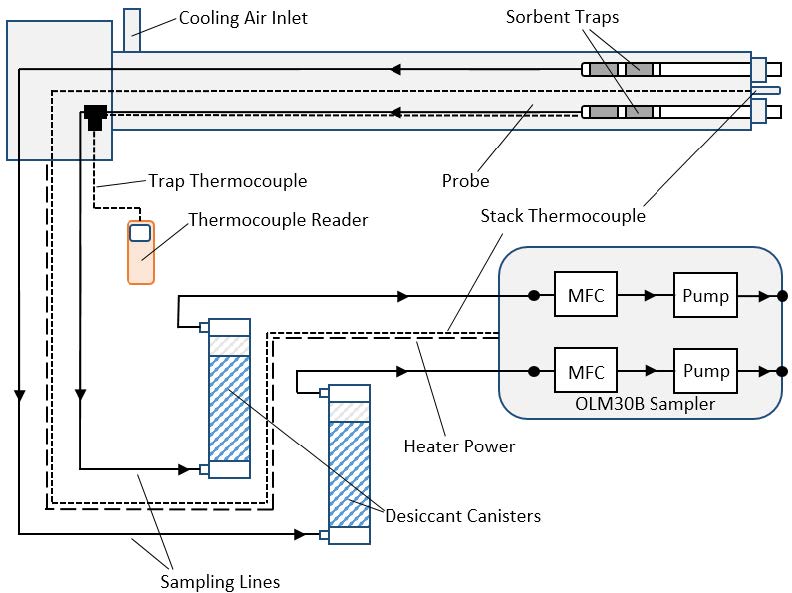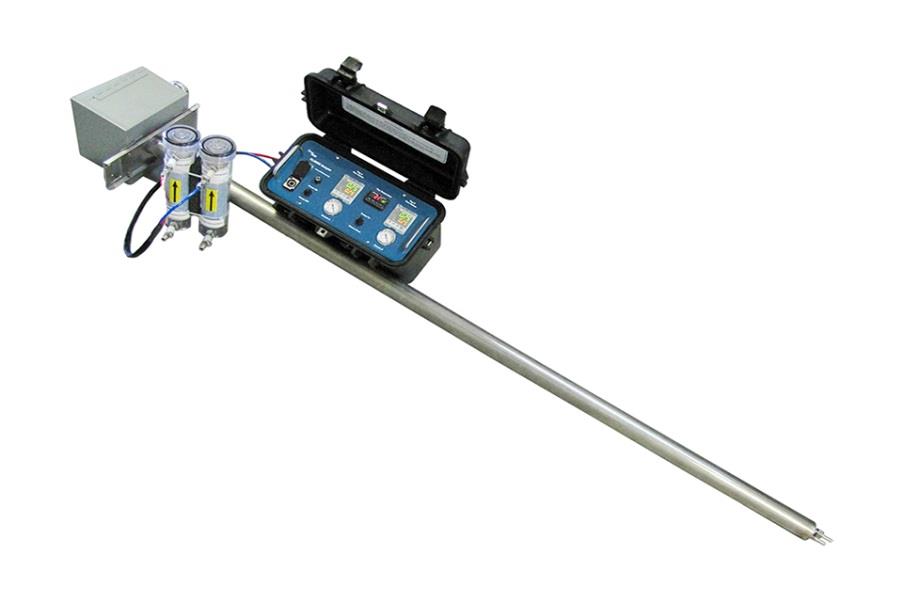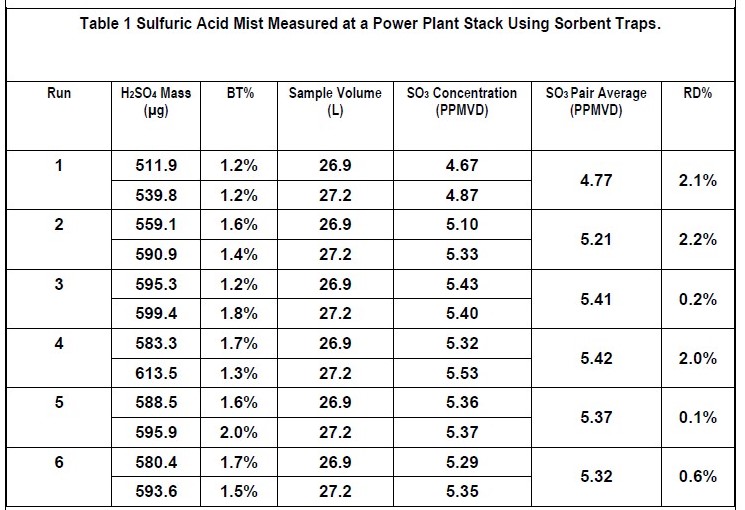In 2018, Ohio Lumex published our sorbent trap technique for measuring short-term SO3/H2SO4/sulfuric acid mist concentration from stationary sources. This was originally published for the Sulphur + Sulphuric Acid International Conference and Exhibition. Upon review, we’ve found this information to still be very relevant and feel that it is still a great resources for understanding our process regarding sorbent traps for sulfuric acid mist measurement.
The SO3 sorbent trap consists of an inert tube packed with beds of sorbent which selectively capture the SO3/H2SO4/sulfuric acid mist from a gas-phase sample. Sorbent trap measurements have a reputation for being simple and cost-effective compared to their impinger method counterparts. Sorbent trap sampling systems are compact, portable, and are usually operated by a single technician. The reference method for sulfuric acid mist in the United States is EPA Method 8 which requires multiple technicians as well as the transportation of expensive equipment and glassware to unforgiving sampling environments.
Sorbent trap methods are designed with built-in performance criteria to ensure measurement quality. These include breakthrough, pair agreement, spike recovery, and additional analytical requirements. The trap method selectively measures sulfuric acid in complex sample matrices including high sulfur dioxide concentrations. Ion Chromatography (IC) is the preferred analytical technique, but new analytical techniques are being developed to make field analysis easy.
The method will be discussed in detail and data are presented. Applications include control technology evaluation, verification of Continuous Emissions Monitor (CEM) measurement quality, and routine emissions “spot-checks”. Ohio Lumex seeks to provide the US EPA with sufficient data to support the sorbent trap technique’s adoption as an alternative to Method 8.
Ohio Lumex has developed several sorbent trap methods which are used to measure gas-phase mercury, speciated mercury, hydrogen halides (HF/HCl/HBr), arsenic, selenium, and ammonia. Sorbent trap methods currently in development include hexavalent chromium, hydrogen sulfide, and siloxanes.
1 Background
1.1 Impinger Methods and EPA Method 8
Many of the EPA Emissions Test Methods, developed well before the turn of the century, were based on sample trains consisting of a series of Greenburg-Smith impingers which contain solutions designed to absorb targeted pollutants out of the sample gas stream. Sampling impinger trains typically requires a team of technicians and significant mobilization time. Sampling locations are often difficult to access and unforgiving to the specialty glassware used in these manual methods. Impinger solutions may consist of hazardous materials which must be transferred and containerized on-site. Impinger train methods are prescribed, and if the procedures are not followed correctly, it is difficult to know that a deviation occurred without observation by a third party.
EPA Method 8 was designed for measuring sulfuric acid mist as well as SO2 at sulfuric acid production facilities. The Method 8 sample train uses 80% isopropanol to selectively capture SO3/H2SO4 and 3% hydrogen peroxide to capture SO2. Since sulfuric acid mist is known to condense, it is possible for biases to result from poor probe-rinsing technique after sampling. According to the FAQ for Method 8 issued on 8/24/16, it works well at sulfuric acid production facilities since the sample streams are dry with no interferences.
1.2 Instrumental Measurements
Instrumental measurements provide the advantage of instantaneous data which are useful for immediate detection of pollution control failures so that rapid corrections may be made. These data are valuable, but come with significant costs to cover installation, maintenance, and troubleshooting. Once installed, it is difficult to move the instrument to a different sampling location. Some measurements require that the sample gas is extracted and transported through a heated line to a distant instrument up to several hundred meters away. These measurements are susceptible to scrubbing (loss of analyte) during the delivery process, especially for condensable analytes such as sulfuric acid mist. Instrument performance should be verified by an appropriate technique which may include a gas-phase matrix spike, an accepted EPA reference method, or a sorbent trap method.
1.3 Instrumental Measurements
EPA Method 30B was promulgated in 2007 and was essential for mercury measurement across several industries through the implementation of widespread mercury emissions regulations within the last 10 years. They are the method of choice for engineering studies where it is necessary to obtain measurements at multiple sampling locations within a single facility. More recently, innovative sorbent technology has opened the door to economical, high quality measurements at many different types of sources. Sorbent trap measurements are advantageous because Sorbent Trap Sampling Systems (STSS) are lightweight, versatile, and easy to use. Isokinetic sampling may be required for sulfuric acid mist measurements and can be easily performed using nozzles designed for typical sorbent trap flow rates. Measurement quality is verified by EPA M30B performance criteria which include Breakthrough (%BT), Pair Agreement (%RD), Spike Recovery (%R), as well as various sampling and analytical checks.
2 Sorbent Trap Methodology
2.1 Sorbent Trap Design
Sorbent traps are inert tubes packed with beds of sorbent designed to remove a specific compound from a gas stream for subsequent analysis. Method 30B style sorbent traps contain two beds of sorbent. The primary capture bed removes the analyte of interest. The purpose of the second bed, or the breakthrough section, is to prove that all or an overwhelming majority of the analyte was captured in the first bed and that none of it escaped through the end of the trap while it was sampled. The SO3 trap was designed to efficiently capture SO3/H2SO4/sulfuric acid mist without interference from SO2.

2.2 Sorbent Trap Sampling System (STSS)
The STSS consists of three primary components: probe, moisture removal device, and sampling console. The probe is stainless steel and typically 6-8 feet long. Sample lines connect the probe to dessicant canisters which remove moisture from the sample gas upstream of volume measurement. The sampling console contains pumps and mass flow controllers which regulate flow rate through the sorbent traps and measure the sample volume. The sampling console also regulates the sorbent trap temperature setting which is preferentially measured by an in-line thermocouple (patent pending). In order to measure the true trap temperature, the in-line thermocouple is inserted directly into the probe liner which contains the traps.


2.3 Quality Assurance/Quality Control Using EPA M30B Performance Criteria
Several of the Method 30B performance criteria used to verify measurement quality are described below. A full description of QA/QC can be found in the method
2.3.1 Breakthrough
Breakthrough is defined as the section 2 analyte mass (S2) divided by the section 1 (primary capture). Acceptable breakthrough is typically <10%, but is typically more lenient in cases where the section 1 mass (S1) is close to the Limit of Quantitation (LOQ) of the analyzer. Failure indicates that section 1 was not sufficiently trapping the analyte.
𝐵𝑇 % = 𝑆2/𝑆1 ×100
2.3.2 Pair Agreement
Traps are sampled in pairs, and the measurement quality is evaluated by how the trap measurements in terms of concentration (C) agree with each other and is expressed as Relative Deviation (RD%). Traps are labelled A and B. The acceptable RD is <10%. Failure could indicate a leaking train or related sampling issue. It could also indicate an analytical failure.
𝑅𝐷 %=|𝐶_𝑎−𝐶_𝑏 |/(𝐶_𝑎+𝐶_𝑏 )×100
2.3.3 Spike Recovery
Spike Recovery (R%) is calculated for a spiked/unspiked pair of traps. The spiked trap should be spiked at 50-150% of the expected capture mass for best results. This is the best indicator of any matrix interferences causing a positive or negative bias on results. Sorbent traps are spiked with a vapor-phase NIST-traceable mass of H2SO4 prior to field tests.
𝑅%=(𝐶𝑟𝑒𝑐×𝑣_𝑠)/𝑚_𝑠𝑝𝑖𝑘𝑒𝑑 ×100
Crec is the measured spike concentration, v_s is the volume sampled through the spiked trap, and m_spiked is the mass of analyte spiked onto the trap.
2.3.4 Leak Checks and Analytical Criteria
A number of additional checks verify that the measurement was performed correctly. Before and after sampling, the technician caps the ends of the traps and turns on the sample pumps. The measured flow should eventually reach zero, which signifies that there were not any leaks in the system and that all of the measured volume went through the traps.
During analysis, the analyst must verify that the calibration curve’s r2 ≥ 0.99 and that each of the points in the calibration yield a calculated value within 10% of the true value. The calibration curve is verified by an independent NIST traceable source prior to analysis. The calibration is also verified by a calibration standard between every 10 samples and at the completion of analysis. The calibration checks are required to fall within 10% of the expected value.
2.4 Sampling Parameters
When sampling sorbent traps for sulfuric acid mist, proper sampling parameters should be used. Flow rate is optimally set close to 1.0 L/min, but may range from 0.3 L/min to 1.2 L/min. Temperature should be set strictly between 200°C and 230°C. When sampling isokinetically, the correct nozzle size should be chosen based on the velocity of the sample gas. The velocity of the sample gas is easily determined by using an S pitot tube and an airflow meter or manometer. The duration of the sample will depend on the flow rate, but for clean sources the traps may be sampled for several hours. Longer runs are possible with proper experimental design.
3.0 DATA
The sorbent traps have been used extensively at coal-fired power plants, a notoriously difficult sample matrix due to high moisture and entrained particulate matter. Table 1 shows data for sorbent traps that were sampled sequentially at a power plant stack. The method’s sensitivity and high precision allow one to detect small changes in sulfuric acid mist concentration caused by process variables. The traps were analyzed by an Ion Chromatograph calibrated with sulfuric acid standards which yielded the captured mass in μg of sulfuric acid. The final concentration was determined after dividing the capture mass by the sample volume and converting to PPMVD of SO3. PPMVD is a dry molar unit and the conversion assumed a molar volume of 24.056 L/mol. Breakthrough and Pair Agreement were calculated according to the equations in section 2.3. The Limit of Quantitation (LOQ) in terms of capture mass is 10 μg, which yields a LOQ of less than 0.1 PPMVD SO3 for a run with roughly 30 L of sample volume.

4.0 Conclusions and Next Steps
Ohio Lumex has successfully refined the SO3 trap to measure SO3/H2SO4/sulfuric acid mist at traditionally difficult sources. The trap method can be easily applied to emissions and engineering measurements in the sulfur industry. The traps provide various advantages over existing methods such as ease of use, cost, and data quality verified by performance criteria. Ion Chromatography is currently used to analyze the sorbent traps and new methods are being developed to open the door to simple on-site analysis. A long-term goal for this method is to test it against the current reference technique using EPA Method 301 so that it can be used as an alternative method or promulgated as a new reference method.
5.0 References
1. U. S. Environmental Protection Agency Method 30B, Revised 8/2/2017: Determination of Total Vapor Phase Mercury Emissions from Coal-fired Combustion Sources using Carbon Sorbent Traps, Research Triangle Park, NC 2017.
2. U. S. Environmental Protection Agency Method 8, Revised 8/3/2017: Determination of sulfuric acid mist and sulfur dioxide emissions from stationary sources, Research Triangle Park, NC 2017.
3. Belo, Lawrence P. Reactions, transformations and impacts of sulfur oxides during oxy-fuel combustion. 2015. PhD Thesis, The University of Newcastle, Callaghan Australia.
4. Evaluation of SO3 Measurement Techniques in Air and Oxy-Fuel Combustion
Daniel Fleig, Emil Vainio, Klas Andersson, Anders Brink, Filip Johnsson, and Mikko Hupa Energy & Fuels 2012 26 (9), 5537-5549
DOI: 10.1021/ef301127x

